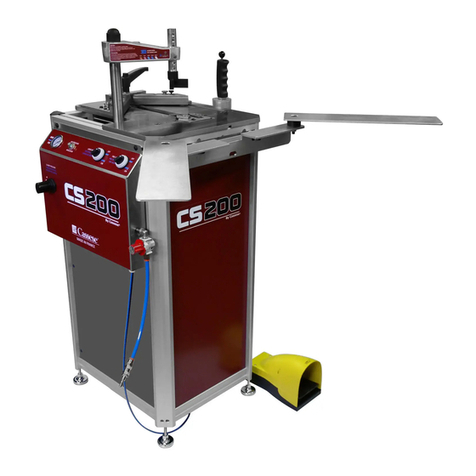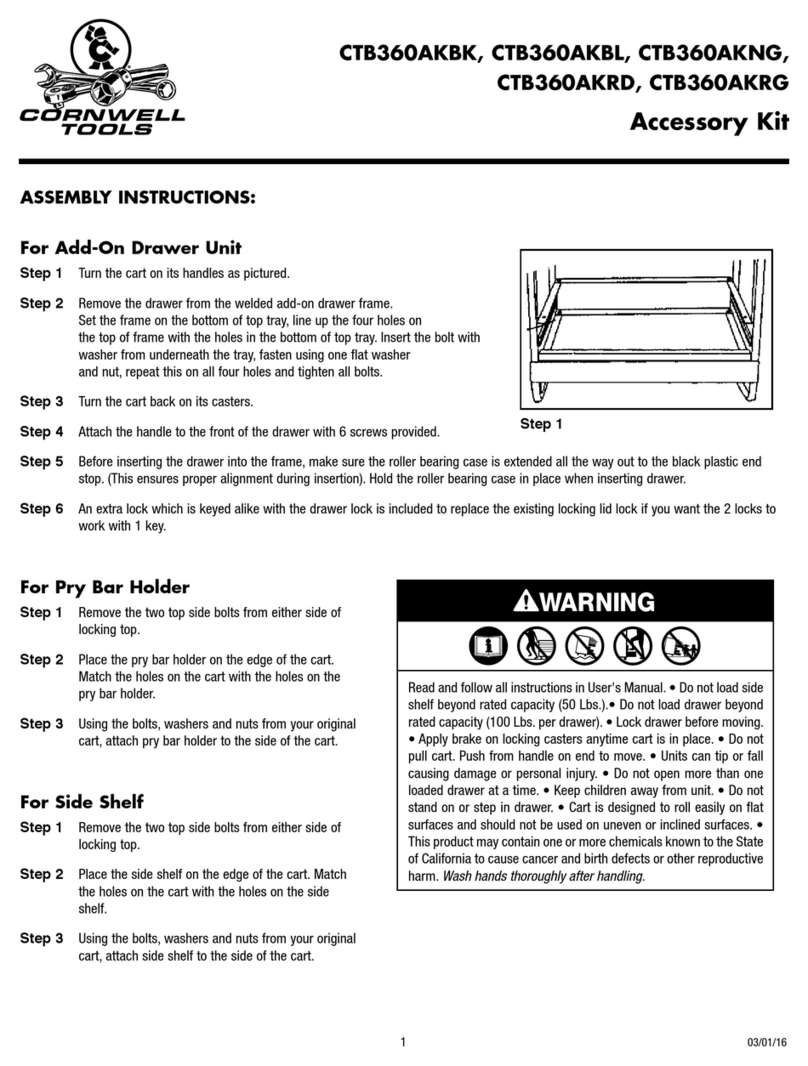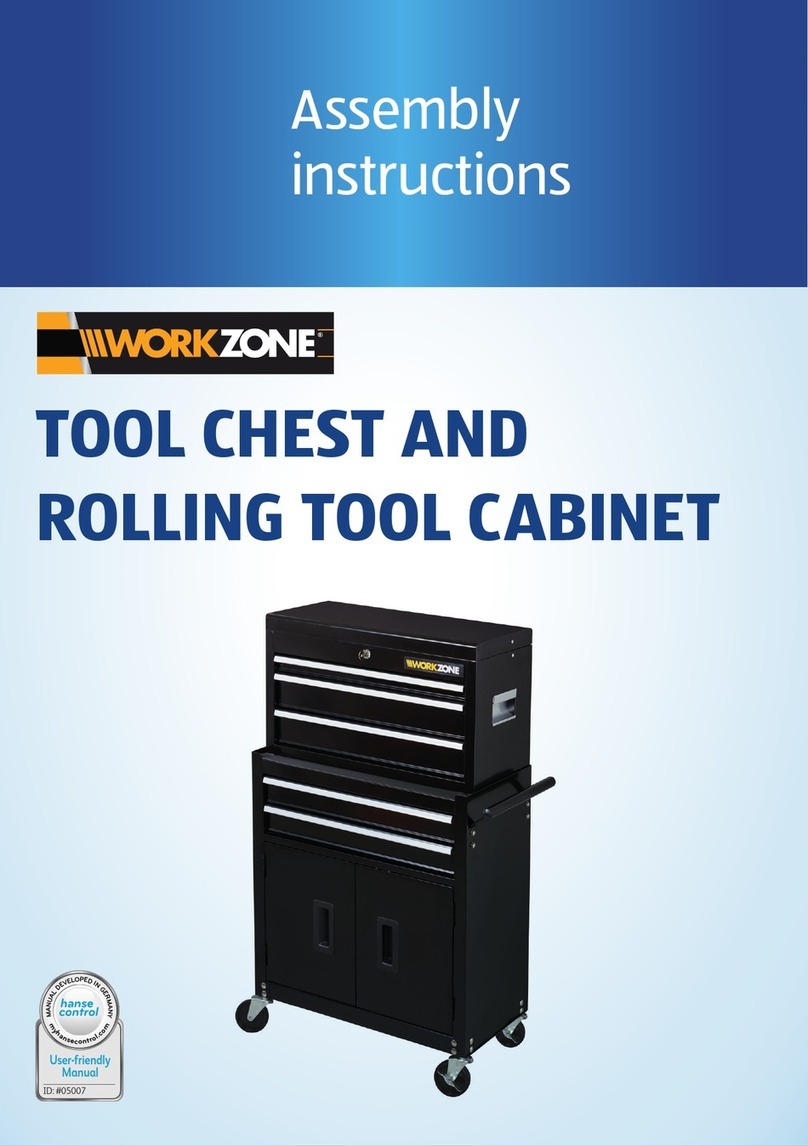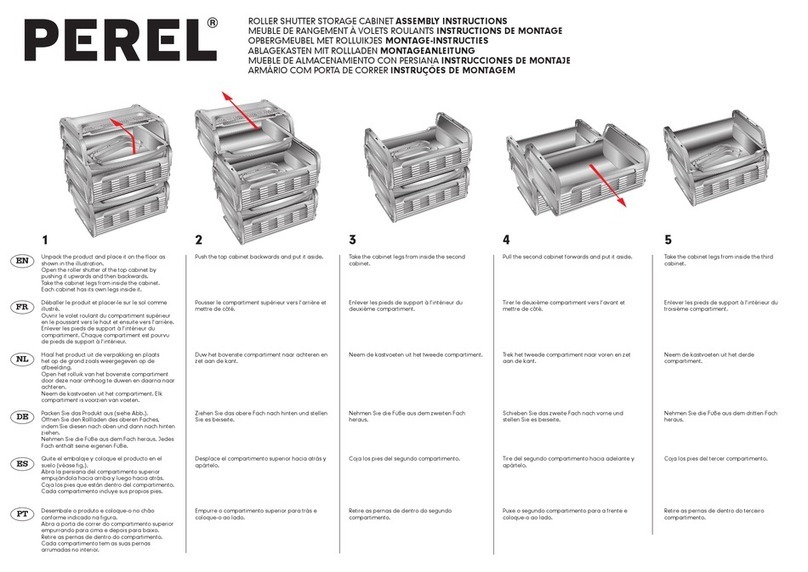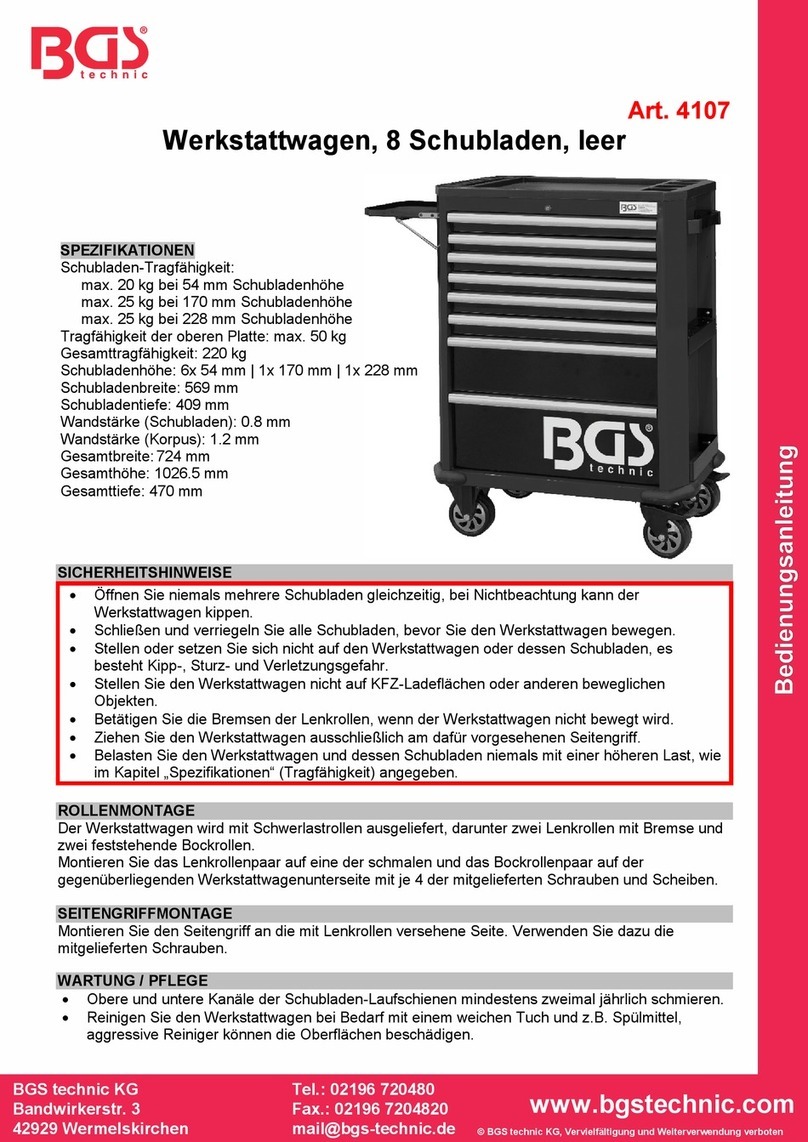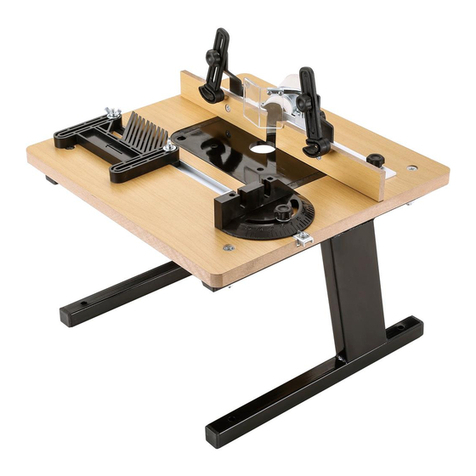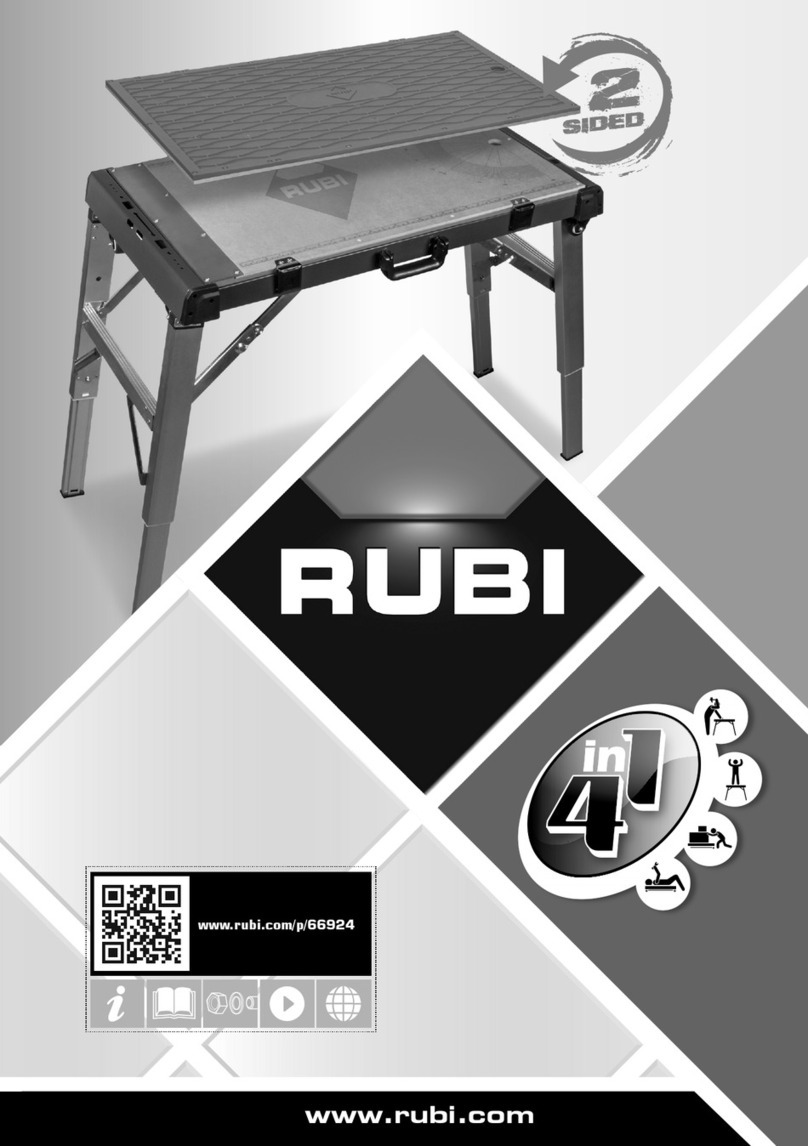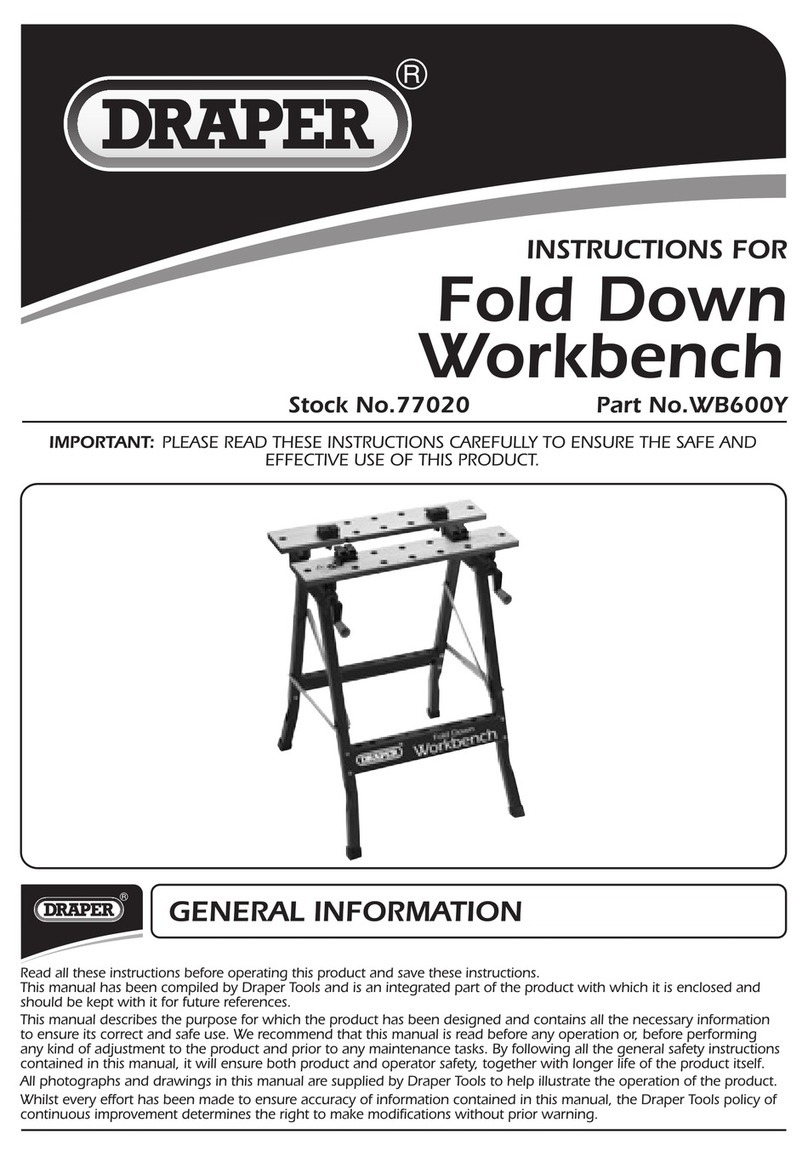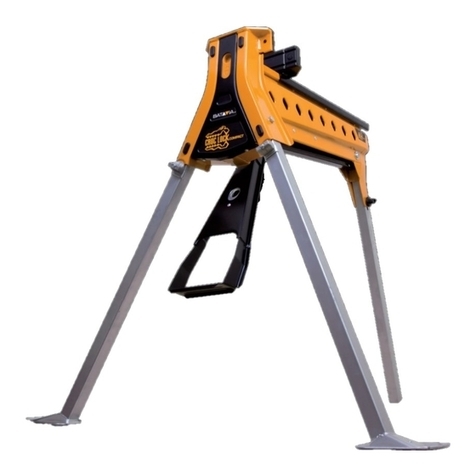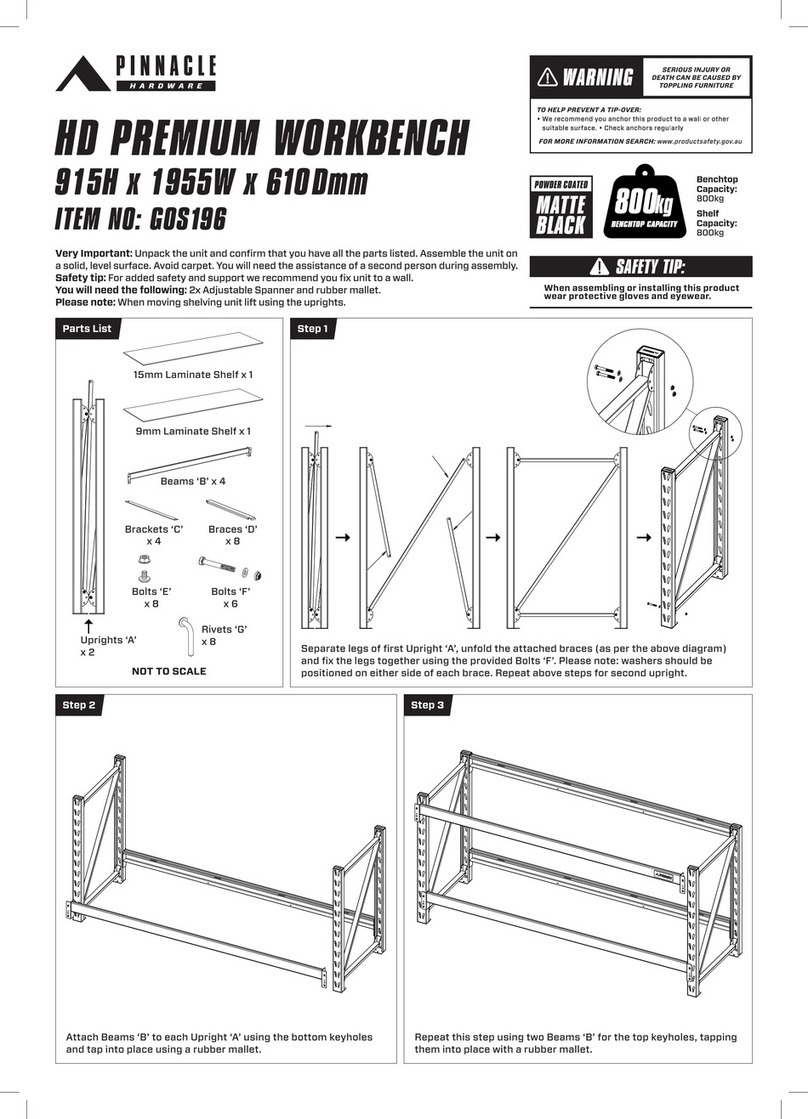Beck Supporter AM 500 FH User manual

TRANSLATION OF THE ORIGINAL VERSION
Reinhold Beck Maschinenbau GmbH
Im Grund 23 | DE -72505 Krauchenwies
Tel.: +49 (0) 7576 / 962 978 - 0 | Fax: +49 (0) 7576 / 962 978 - 90
E-Mail: info@beck-maschinenbau.de | Web: https://www.beck-maschinenbau.de
Operating Manual
Height-adjustable Work and Assembly Benches
Supporter AM 500 FH and AM 1200 FH
Supporter AM 400 ESA and AM 500 ESA
Valid for Supporter types:
AM 500 FH and AM 1200 FH
AM 400 ESA and AM 500 ESA

2
BA_BM_AM-400-500-1200_EN_46-21.docx
Table of Contents
1Introduction.............................................................................................................................................................4
1.1 Legal Notice.................................................................................................................................................................................. 4
1.2 Illustrations .................................................................................................................................................................................. 4
2Symbols ...................................................................................................................................................................4
2.1 General Symbols .......................................................................................................................................................................... 4
2.2 Symbols in Safety Instructions...................................................................................................................................................... 5
3General ....................................................................................................................................................................6
3.1 Advantages................................................................................................................................................................................... 6
3.2 Applications.................................................................................................................................................................................. 6
3.3 Target Group and Previous Experience ........................................................................................................................................ 6
3.4 Requirements for the Operators.................................................................................................................................................. 6
3.5 Accident Prevention..................................................................................................................................................................... 7
3.6 General Safety Regulations .......................................................................................................................................................... 7
3.7 Standard Equipment .................................................................................................................................................................... 7
3.8 Options and Accessories .............................................................................................................................................................. 7
4Safety.......................................................................................................................................................................8
4.1 Basic Safety Instructions............................................................................................................................................................... 8
4.2 Application Area and Intended Use.............................................................................................................................................. 8
4.3 Improper Use ............................................................................................................................................................................... 8
4.4 Consequences in Case of Disregard.............................................................................................................................................. 9
4.5 Conversions and Modifications of Supporter............................................................................................................................... 9
4.6 Load Distribution and Influence on the Nominal Load................................................................................................................. 9
4.7 Hazardous Areas ........................................................................................................................................................................ 10
4.8 Residual Risks............................................................................................................................................................................. 11
4.9 Observe the Environmental Protection Regulations .................................................................................................................. 11
4.10 Organisational Measures ........................................................................................................................................................... 12
4.11 Personnel Selection and Qualification - Basic Duties.................................................................................................................. 12
5Technical Specifications.........................................................................................................................................13
5.1 Manufacturer and Nameplate.................................................................................................................................................... 13
6Transport to the Installation Site...........................................................................................................................14
6.1 Unloading the Supporter............................................................................................................................................................ 14
6.2 Requirements for the Installation Site ....................................................................................................................................... 15
6.3 Temporary Storage..................................................................................................................................................................... 15
6.3.1 Short Term Storage ......................................................................................................................................................... 15
6.3.2 Long Term Storage .......................................................................................................................................................... 15
6.4 Lashing on a Transport Vehicle .................................................................................................................................................. 15
7Components and Controls.....................................................................................................................................16
7.1 Basic Equipment AM 500 FH & AM 1200 FH .............................................................................................................................. 16
7.2 Basic Equipment AM 400 ESA & AM 500 ESA............................................................................................................................. 17
8Installation and Commissioning.............................................................................................................................18
9Operation ..............................................................................................................................................................18
9.1 Loading and Unloading the Platform.......................................................................................................................................... 18

3
BA_BM_AM-400-500-1200_EN_46-21.docx
9.2 Lifting and Lowering the Platform.............................................................................................................................................. 18
9.3 Moving the Supporter via Swivel Castors................................................................................................................................... 18
9.4 Height Adjustment..................................................................................................................................................................... 19
9.4.1 AM 500 FH / AM 1200 FH................................................................................................................................................ 19
9.4.2 AM 400 ESA / AM 500 ESA .............................................................................................................................................. 19
10 Vacuum Clamping Unit (Option)............................................................................................................................20
10.1 Switching on the Vacuum Pump................................................................................................................................................. 20
10.2 Clamping a Workpiece ............................................................................................................................................................... 21
10.2.1 Clamping the Workpiece with Vacuum Suction Cups...................................................................................................... 21
10.2.2 Clamping a Workpiece with the Universal Clamping Plate.............................................................................................. 21
10.3 Unclamp Workpiece................................................................................................................................................................... 22
10.3.1 Technical Specifications of the Vacuum Pump ................................................................................................................ 22
11 Troubleshooting ....................................................................................................................................................23
12 Maintenance and Repair .......................................................................................................................................24
12.1 Maintenance Intervals ............................................................................................................................................................... 24
13 Decommissioning ..................................................................................................................................................24
14 Disassembly and Scrapping ...................................................................................................................................25
15 Options and Accessories........................................................................................................................................26
15.1 Table Tops, Shelves, Supports etc. ............................................................................................................................................. 26
15.2 Vacuum Clamping Unit............................................................................................................................................................... 28
15.3 Drawers, Tool Cabinets and other Accessories........................................................................................................................... 29
15.4 AM 500 FLEXX | FH and AM 1200 FLEXX | FH............................................................................................................................ 30
15.4.1 Table Tops for AM 500 - 1200 FLEXX | FH ....................................................................................................................... 31
EU - Declaration of Conformity.......................................................................................................................................32
List of Figures
Figure 1: Permissible load with load distribution............................................................................................................................................... 9
Figure 2: Nameplate ........................................................................................................................................................................................ 13
Figure 3: Transport to installation site............................................................................................................................................................. 14
Figure 4: Basic equipment AM 500 FH & AM 1200 FH..................................................................................................................................... 16
Figure 5: Basic equipment AM 400 ESA & AM 500 ESA.................................................................................................................................... 17
Figure 6: Food pedal for height........................................................................................................................................................................ 19
Figure 7: Control panel with buttons ............................................................................................................................................................... 19
Figure 8: Vacuum clamping unit ...................................................................................................................................................................... 20
Figure 9: Vacuum suction cups ........................................................................................................................................................................ 20
Figure 10: Universal clamping plates ............................................................................................................................................................... 20
Figure 11: Vacuum main switch....................................................................................................................................................................... 20
Figure 12: Suction cup valve ............................................................................................................................................................................ 21
Figure 13: Quick release coupling.................................................................................................................................................................... 21
Figure 14: Rubber sealing strip ........................................................................................................................................................................ 21
Figure 15: Place workpiece .............................................................................................................................................................................. 21
Figure 16: Machining workpiece...................................................................................................................................................................... 21
Figure 17: Swivel clamping plate...................................................................................................................................................................... 22
Figure 18: Foot switch for unclamping the workpiece..................................................................................................................................... 22
Figure 19: Remove workpiece.......................................................................................................................................................................... 22
Figure 20: AM 500 -1200 FLEXX | FH ............................................................................................................................................................... 30
Revisions:
Revision
Autor
Modification
Date
001
AG
Original manual translated
17-11-2021

4
BA_BM_AM-400-500-1200_EN_46-21.docx
1Introduction
The information in this operating manual enables safe, proper and economical operation of your work and as-
sembly bench. Please observe all the explanations, notes and regulations
•to avoid dangers and malfunctions,
•to reduce repair costs and downtimes
•and to increase reliability and service life
of your work and assembly bench.
The operating manual must be read and used by each person entrusted with carrying out work with the work
and assembly bench. This must be ensured by the operator. Further this manual as well as any appendices and
additional documents must be kept easily accessible at the place of use of the work and assembly bench.
Ignorance or non-observance of these operating instructions may result in certain accident
hazards during handling with the work and assembly bench. Before commissioning, this op-
erating manual and any appendices and additional documents must be read thoroughly. All
instructions, in particular the safety regulations, must be observed!
Handling the supporter in the sense of these instructions means
•the installation and commissioning,
•the operation and proper usage,
•the influence on operating conditions, as well as
•the maintenance, troubleshooting and repair.
Apart from the operating manual and the legally binding accident prevention provisions applicable in the country
and place of use, the recognized technical regulations for safe and proper work must also be observed.
1.1 Legal Notice
All contents of these operating instructions are subject to the rights of use and copyright of Reinhold Beck Mas-
chinenbau GmbH. Any reproduction, modification, further use and publication in other electronic or printed me-
dia, as well as their online publication, requires the prior written consent of Reinhold Beck Maschinenbau GmbH.
1.2 Illustrations
All photos, figures and graphics contained in this document are for illustration and better understanding only
and may differ from the current state of the product.
2Symbols
2.1 General Symbols
Symbol
Meaning
Indicates passages within this operating manual that must be particularly observed in order to
prevent malfunctions or damage to the work and assembly bench.
Refers to chapters, sections, or figures within this document.
Refers to an external document or a third-party source.

5
BA_BM_AM-400-500-1200_EN_46-21.docx
2.2 Symbols in Safety Instructions
The supporter is designed and manufactured according to the current state of the art. Nevertheless, residual
hazards may occur during handling. In this operating manual, possible dangers and residual risks are pointed out
at appropriate places.
Safety instructions are provided with corresponding danger symbols which have the following meanings:
Symbol
Safety Instruction
Reading and applying the operating manual is mandatory for the operating personnel.
Failure to abide by the following precautions could lead to serious or possibly fatal injury.
General danger symbol, which requires the highest attention!
Failure to observe may result in damage to the equipment, serious injury or even death.
This symbol warns of the dangers of electric voltage!
Failure to observe may result in damage to the equipment, serious injury or even death.
Reference to a prohibited zone under a lifted load!
Do not enter! There is an increased risk of injury or even death.
Reference to a prohibited zone on a platform!
Do not enter! There is an increased risk of injury or even death.
Reference to a possible crushing hazard!
Non-observance increases the risk of injury to hands and fingers!
Reference to a possible crushing hazard!
Non-observance increases the risk of injury to feet and toes!
Possible dangerous crushing hazard in the area of stationary objects!
Risk of personal injury and possibly additional equipment damage.
Reference to a possible hazard due to forklift traffic!
Non-observance can result in life-threatening injuries.
Reference to a possible danger under suspended loads!
Non-observance can result in life-threatening injuries.
Reference to possible tripping and slipping hazards on the floor!
Non-observance may result in minor or severe injuries.
Reference to possible environmental pollution!
Non-observance poses a risk of pollution of the environment and groundwater!
Reference to the obligation to wear safety shoes resp. protective gloves!
Non-observance may result in increased risk of injury to feet & toes or hands & fingers!
Fire hazard! Do not smoke and do not ignite open fire.
Access for unauthorized persons prohibited!
Risk of personal injury and possibly additional equipment damage.

6
BA_BM_AM-400-500-1200_EN_46-21.docx
3General
The operating manual must be read carefully and understood before handling the
work and assembly bench! If anything is unclear, please contact the manufacturer.
The AM supporter series was specially developed for manual workstations in manufacturing, assembly and
maintenance. The various models already cover a wide range of applications. In addition, a comprehensive range
of accessories allows for even better adaptation to different applications.
3.1 Advantages
•Back-friendly height adjustment, either foot-hydraulically (FH series)
or via electric spindle adjustment (ESA series)
•Uniform adjustment to height even under uneven load distribution
•The side walls provide stability and protect the mechanics
•Solid construction with high-quality hydraulic units
•Table top moves absolutely parallel and smoothly
•4 stable and robust swivel castors with 2 brakes
3.2 Applications
Supporters of the AM series can be used for all work corresponding to its intended use in section 4. The sup-
porter is suitable for use as work equipment for transporting, lifting and lowering loads and also as a height-
adjustable assembly table. Typical areas of application are workplaces in manufacturing, assembly and mainte-
nance, where precise height adjustment for ergonomic working as well as high flexibility and mobility are of
particular importance.
The supporter must not be used for work that does not correspond to its intended use (see section 4).
3.3 Target Group and Previous Experience
This operating manual is intended for the operating and maintenance personnel of the work and assembly bench.
The operating personnel is to be determined by the operator and must further meet the following requirements:
•Basic technical and mechanical knowledge as well as knowledge of the associated technical terms
•Reading and understanding these operating and maintenance instructions
In order to acquire the knowledge required to operate this work and assembly bench, the operator must ensure
the following measures:
•Product training for every operator (also possible external personnel)
•Regular safety instruction
3.4 Requirements for the Operators
The operator is responsible for the safe use of the work and assembly bench!
The supporter may only be operated by trained personnel who have also read this manual.
Inspection, maintenance, cleaning and repair may only be performed by technical specialists
with product-specific training and mechanical and/or electrical training.
Specialists with product-specific training are to be commissioned and held responsible for
planning and checking the work.
The national protective regulations for employees must be observed
The legal minimum age must be observed.

7
BA_BM_AM-400-500-1200_EN_46-21.docx
3.5 Accident Prevention
To avoid accidents, the following rules must be observed for operation:
Prevent unauthorized persons from gaining access to the work and assembly bench.
Keep unauthorized persons away from the danger areas.
Repeatedly inform present other persons about existing residual risks (see section 4.8 "Residual Risks").
Conduct and record regular training & instruction for persons who must be in the area of the work and
assembly bench.
New employees must be trained internally to work on a supporter and this training must be documented.
It is not permitted to enter the supporter platform or to transport resp. lift persons.
3.6 General Safety Regulations
In general, the following safety regulations and obligations apply when handling the work and assembly table:
The supporter may only be operated when it is in perfect working order.
It is prohibited to remove, modify or bypass any protective, safety or monitoring equipment.
It is forbidden to modify or alter the supporter without the written approval of the manufacturer / supplier.
Faults or damage must be reported to the operator immediately, eliminated without delay and repaired if
necessary.
Repair and maintenance work on electric, hydraulic, and pneumatic components (e.g. electric drives, hy-
draulic cylinders, vacuum pumps, etc.) may only be performed by authorized and trained personnel.
Maintenance must be carried out and documented in accordance with the maintenance instructions.
For repairs, only original spare parts from the manufacturer may be used.
Only instructed, trained or qualified persons may work on the work and assembly bench.
For the operation of the work and assembly bench, the respective national safety regulations for
employees as well as the national safety and accident prevention regulations apply.
3.7 Standard Equipment
•Without table top and shelf (bottom) as standard.
•Uniform height adjustment even with uneven load distribution or eccentric loading.
•The AM 500 FH and AM 1200 FH models are steplessly foot-hydraulically height-adjustable (via a foot
pedal mounted on the left side with separate pedal surfaces for up/down).
•The AM 400 ESA and AM 500 ESA models are infinitely height-adjustable (electrically via spindle motor,
by two synchronous actuator drives with control board and push buttons for up/down).
•Additional space under the worktop (e.g. for optional shelf and lower tool cabinet).
•4 swivel castors (Ø 125 mm), 2 with brake
•CE-compliant version
3.8 Options and Accessories
•Special accessories and optional components can be found in chapter 15.

8
BA_BM_AM-400-500-1200_EN_46-21.docx
4Safety
4.1 Basic Safety Instructions
Work and assembly benches can be dangerous if used improperly. Therefore, observe the safety instructions
listed in this chapter and the accident prevention regulations of your employer's liability insurance association!
The manufacturer accepts no liability for damage and malfunctions resulting from failure to
observe these operating instructions.
4.2 Application Area and Intended Use
The hydraulically adjustable supporters of the AM series conform to the Machinery Directive 2006/42/EC and
are therefore suitable as technical equipment for both industrial and commercial applications as well as for train-
ing purposes in educational institutions.
Improper use can lead to danger to persons and to a defect or damage to the supporter
The supporter is primarily intended for operation in covered indoor areas, but it can also be used outdoors
for loading and unloading purposes (e.g. from the service vehicle to the place of use).
Work on the supporter may only be performed at sufficiently illuminated workplaces.
The supporter is intended for processing, equipping, assembling and transporting assemblies, workpieces
and similar components as well as for lifting, lowering and moving loads.
The supporter may only be used on horizontal floors for lifting loads.
The supporter may only be moved when the load is lowered.
The supporter must be positioned freely in the room when lifting and lowering. This means
that no shearing or crushing edges may be caused by the movement of the work and assembly bench.
The maximum load (see 5 “Technical Specifications”) with load center in the middle of the supporter
must not be exceeded. If the supporter is loaded unevenly, outside the load center of gravity, the load ca-
pacity is of the maximum permitted load capacity (see Figure 1).
The supporter is not intended for moving and transporting persons.
The supporter must not be operated in potentially explosive working areas. Any other use is considered
improper and prohibited.
4.3 Improper Use
Improper use is when the supporter is used for purposes other than those prescribed in this operating manual
and in section 4, for example
Use and application for private or non-commercial purposes,
Use in disregard of the regulations in the operating manual,
use after unauthorized conversions or modifications,
Exceeding the maximum permissible load (see Fehler! Verweisquelle konnte nicht gefunden werden. “
Technical Specifications”)
Transporting or conveying persons with the work and assembly bench
Entering the work and assembly bench
In case of improper use of the work and assembly bench, any warranty, liability and other claims for damages of
the operator against the manufacturer are excluded!

9
BA_BM_AM-400-500-1200_EN_46-21.docx
4.4 Consequences in Case of Disregard
If the supporter is not operated, maintained or repaired in accordance with the safety regulations, not as in-
tended, improperly or in an abusive manner, the following will result:
Dangers to the health of the operating personnel
Dangers to the supporter and objects in its vicinity
Impairment of the supporter function
In case of improper use of the work and assembly bench, any warranty, liability and other claims for damages
of the operator against the manufacturer are excluded!
4.5 Conversions and Modifications of Supporter
Only use the supporter in its original condition, i.e. as delivered!
The components of the supporter must not be changed in their type and condition.
Only original spare parts and accessories from the manufacturer (see 15) may be used.
Deviations are not permitted.
Unauthorized modifications or conversions by the operator, without the written consent of
the manufacturer, are prohibited. This excludes any warranty, liability and other claims for
damages by the operator against the manufacturer!
4.6 Load Distribution and Influence on the Nominal Load
The nominal, maximum permissible load of supporter is based on a load evenly distributed on the platform. If
the load cannot be distributed evenly on the platform, the maximum permissible load must be reduced according
to the figures below.
Figure 1: Permissible load with load distribution
Even distribution
Load is evenly distributed
over the entire platform area
→100 % of the nominal load
is permissible.
Uneven distribution
Load is distributed over half of the
platform in transverse direction
→50 % of the nominal load
is permissible.
Uneven distribution
Load is distributed over half of the
platform in longitudinal direction
→33 % of the nominal load
is permissible.
max. 100 % max. 50 % max. 33 %

10
BA_BM_AM-400-500-1200_EN_46-21.docx
4.7 Hazardous Areas
Source
Area
Cause
Risk
Prevention
Foot pump
On the foot pedal for
height adjustment
Slipping off the
foot pedal
Injuries to feet
and legs
Keep foot pedal
and shoes dry
Wear work shoes
with non-slip soles
Mechanics
Under the
table top
Crushing and
shearing points
Loss of limbs,
crushing of
hands, increased
risk of injury and
even death
Do not reach under the
table top during opera-
tion and do not move
your body into this area
Hydraulic
system
On hydraulic
cylinders and all oil-
bearing parts, seals
and lines
Oil spraying
out with high
pressure in
case of damaged
cylinder or seals
Injuries and
poisoning of
the eyes
Wear safety goggles
or face shield
Repair damaged parts
and/or seals immedi-
ately (only qualified
personnel!)
Pneumatics
Rear openings of the
Vacuum pump
Outflowing air,
gases and dust
Injuries
of the eyes
Do not look into the
openings, wear safety
goggles or face shield
Electrics
At the mains
connection and at
the motor control
unit as well as at all
intervening current-
carrying parts and
cables
Electrical voltage
(230 VAC)
Electric shocks
with increased
risk of injury
up to death
Avoid moisture
Have defective parts /
insulation repaired
immediately (only
qualified personnel!)
Do not touch energised
components

11
BA_BM_AM-400-500-1200_EN_46-21.docx
4.8 Residual Risks
The supporter is built according to the latest state of the art and the recognised safety rules. Nevertheless, the
use of the supporter may cause danger to life and limb of the user or third parties or damage to the supporter
and other equipment. Due to the construction of the supporter, the following residual risks can occur even when
used as intended and despite compliance with all relevant safety regulations:
Reading and applying the operating manual is mandatory for the operating personnel.
Be alert to possible crushing hazards:
a) when transporting the supporter by forklift truck: between forks & pallet / supporter
b) when picking up the supporter: between supporter / pallet and floor
c) when lowering the supporter: between supporter and fixed equipment
Be alert to possible crushing hazards when lowering the supporter (from the cargo pallet to the
floor) with a forklift truck or overhead crane.
Be aware of the danger from falling objects such as workpieces, tools or similar. Therefore, wear
safety shoes, especially when transporting and setting down the supporter.
It is strictly forbidden to "ride along" with the supporter during a lifting operation (by means of a
forklift truck or overhead crane). There is a high risk of falling!
It is strictly forbidden to enter or climb onto the supporter during a lifting operation (by means of a
forklift truck or overhead crane). There is a high risk of falling!
Increased risk of injury or even death. Entering the danger zone under a lifted load during transport
or installation by means of a forklift truck is prohibited!
Increased risk of injury or even death. It is forbidden to enter the forklift platform during transport
or installation!
Unauthorised persons are not allowed to enter the supporter installation area (responsibility of the
operator).
Danger of electric shock on models with battery-operated hydraulic height adjustment!
Work on the electrical components may only be carried out by qualified personnel.
Be aware of possible tripping and slipping hazards on the floor. Prevent possible hazards by
keeping the floor dry and clean and by using anti-slip floor coverings around the supporter.
Acute danger of crushing underneath the table top! Never reach into the shears and never move
your body into this area! There is an increased risk of accidents with loss of limbs or even death.
When using additional machines on the supporter, first read the respective operating instructions
and comply with the specified safety regulations.
Be aware of the fire hazard during the processing of wood due to wood dust, in connection with
flying sparks and/or open fire!
Danger of electric shock on models with battery-operated hydraulic height adjustment!
Work on the electrical components may only be carried out by qualified personnel.
4.9 Observe the Environmental Protection Regulations
During all work with the supporter, the environmental protection regulations, obligations and laws for waste
avoidance and proper recycling and/or disposal applicable at the place of use must be observed. This applies in
particular to installation, repair and maintenance work involving substances that could pollute the groundwater
(e.g. hydraulic oils and cleaning agents and liquids containing solvents). In any case, prevent them from seeping
into the ground or entering the sewage system.
Store and transport the above-mentioned hazardous substances only in suitable containers.
Avoid leakage of hazardous substances by using suitable collection containers. Ensure that
the above-mentioned substances are disposed of by a qualified disposal company.

12
BA_BM_AM-400-500-1200_EN_46-21.docx
4.10 Organisational Measures
Always keep this operating manual within easy reach and at the place of use of the supporter.
In addition to the operating manual, observe and instruct on generally applicable legal and other binding
regulations for accident prevention and environmental protection.
Supplement the operating manual with further instructions, including supervisory and reporting duties, to
take account of special operational features (e.g. with regard to work organisation, work processes, per-
sonnel employed).
Before starting work on the supporter, the person responsible for its operation must have read the oper-
ating instructions, especially the chapter "Safety Instructions". This applies in particular to personnel who
only occasionally work on the supporter.
Check that work is carried out in a safety-conscious and hazard-conscious manner and in compliance with
the operating manual.
When using additional machines on the supporter, read the respective operating instructions and keep
them handy. Pay particular attention to the respective safety and hazard information.
In case of safety-relevant changes to the supporter or its operating behaviour, shut down the entire sys-
tem immediately and report the fault to the responsible office/person.
Use personal protective equipment as necessary or required by regulations.
Do not make any modifications, additional attachments or conversions to the supporter without the man-
ufacturer's approval! This will compromise safety and invalidate the manufacturer's warranty and any lia-
bility claim.
Spare parts must meet the technical requirements specified by the manufacturer. The exclusive use of
original spare parts ensures this. Therefore, only use original spare parts from the manufacturer.
Observe the fire alarm and firefighting possibilities. Make the location and operation of fire extinguishers
(fire class ABC) known. Do not use water!
4.11 Personnel Selection and Qualification - Basic Duties
The design and operation of the supporter is equally suitable for right- and left-handers.
The supporter is designed to be operated by a single person. Other persons in the vicinity of the supporter
must keep a suitable safety distance.
Work on and with the supporter may only be carried out by reliable personnel.
Observe the legal minimum age!
Only use trained or instructed personnel. Clearly define the responsibilities of the personnel for operating,
setting up, maintaining and repairing!
Ensure that only authorised personnel work on the supporter!
If personnel to be trained or apprenticed have to work on the supporter, this may only be done under the
constant supervision of an experienced resp. qualified person.
Work on hydraulic equipment may only be carried out by authorised and trained personnel.
Work on the electrical equipment of the supporter may only be carried out by a qualified electrician or by
instructed persons under the direction and supervision of a qualified electrician in accordance with the
electrotechnical regulations.

13
BA_BM_AM-400-500-1200_EN_46-21.docx
5Technical Specifications
Version
AM 500 FH
AM1200 FH
AM 400 ESA
AM500 ESA
Article number
210.100.00
210.200.00
212.300.00
212.310.00
Platform size1
1460 x 740 mm
1460 x 740 mm
1460 x 740 mm
1460 x 740 mm
Total height
970 mm
970 mm
970 mm
970 mm
Supporter height
670 mm
670 mm
670 mm
670 mm
Effective stroke
300 mm
300 mm
300 mm
300 mm
Lifting speed
manually
manually
approx. 6 mm/s
approx. 10 mm/s
Clear width (columns)
1105 mm
1105 mm
1105 mm
1105 mm
Swivel castors
4 x Ø 125 mm
4 x Ø 125 mm
4 x Ø 125 mm
4 x Ø 125 mm
Number of brakes
2
2
2
2
Height adjustment
hydraulically
hydraulically
spindle motor
spindle motor
Control elements
foot pedal
foot pedal
push-buttons
push-buttons
Load capacity
max. 500 kg
max. 1200 kg
max. 400 kg
max. 500 kg
Net weight2
approx. 120 kg
approx. 150 kg
approx. 135 kg
approx. 140 kg
Hydraulic power units
1 x left
1 x left / 1 x right
none
none
Electric drives
none
none
1 x left / 1 x right
1 x left / 1 x right
Connection voltage
none
none
230 VAC / 50 Hz
230 VAC / 50 Hz
Type of connection
none
none
earthed connector
earthed connector
5.1 Manufacturer and Nameplate
Manufacturer:
Reinhold Beck Maschinenbau GmbH
Im Grund 23
DE-72505 Krauchenwies (Germany)
Phone: +49 (0) 7576 / 962 978 - 0
Fax: +49 (0) 7576 / 962 978 - 90
Email: [email protected]
Nameplate:
The nameplate provides information about the characteristic values of
your supporter:
Figure 2: Nameplate
Note: Before using the unit in a way that deviates from the described suitability (see section 4), it is essential
to consult the manufacturer. Otherwise all warranty, liability and other claims for damages of the operator
against the manufacturer will be voided!
1
Platform size does not include optional table top, which is available as an accessory.
2
The net weight refers to the basic equipment without table top and other accessories.

14
BA_BM_AM-400-500-1200_EN_46-21.docx
6Transport to the Installation Site
Only trained personnel may be used for the following work:
•Transport the supporter
•Unloading the supporter
•Check delivery condition of the supporter
6.1 Unloading the Supporter
There is an increased risk of accidents when unloading and transporting the supporter!
The supporter can fall or tip over due to its weight!
Use only suitable and technically perfect lifting gear and suspension systems with an
adequate lifting capacity of 500 kg. Only transport the supporter on level, solid ground!
When placing the supporter, pay attention to the possible danger of crushing in the area
of stationary objects around the supporter!
Warning: Increased risk of injury and death! Never stand under the load when lifting
and putting it down! Instruct bystanders to leave the danger zone!
Warning: Increased risk of injury and death! Do not enter or climb onto the forklift
platform during transport!
Increased risk of crushing feet and toes! Wear steel-toed safety shoes!
Unloading by forklift truck
•With the forks set appropriately, drive centrally into the designated places on the freight pallet on the longi-
tudinal side of the supporter and lift carefully.
•Carefully lift the supporter from the truck. The net weight is approx. 120 kg (AM 500 FH), approx. 150 kg (AM
1200 FH), approx. 135 kg (AM 400 ESA) and approx. 140 kg (AM 500 ESA), each without accessories.
Check delivery condition
•Check for completeness and transport damage. In case of transport damage or missing parts, document these
immediately on the consignment note of the transport company. At the same time, inform the manufacturer
of the situation.
Transport to the installation site
•Transport the supporter to the installation site with a forklift truck or
pallet truck, in accordance with the general safety regulations.
Unpacking and placing
•Unpack the supporter and remove the packing material. Then lift the
supporter from the transport pallet with a forklift. When doing so,
drive under the centre of the long side of the supporter with appro-
priately adjusted forks (see Figure 3). Then lift carefully from the
pallet, remove the pallet and set the supporter down on the ground.
Figure 3: Transport to installation site
Dispose of the packaging material in an environmentally friendly manner!
Fire hazard! Do not smoke or light an open fire

15
BA_BM_AM-400-500-1200_EN_46-21.docx
6.2 Requirements for the Installation Site
The following guidelines apply with regard to space requirements, load-bearing capacity and the condition of
the substrate:
•Space requirements: B x H x T = 1600 x 700 x 800 mm (with table top)
•Load capacity: Concrete of classification B 15
•Conditions: Level, smooth, non-slip and tilt-free
6.3 Temporary Storage
If the supporter is not put into operation immediately after delivery, it must be stored carefully in a protected
place. Carefully cover the entire supporter so that neither dust nor moisture can penetrate.
6.3.1 Short Term Storage
•Dry environment
•Protect components at risk of corrosion
•Park in a stable place
6.3.2 Long Term Storage
•Dry environment
•Protect components at risk of corrosion
•Protect supporter from dirt
•Park in a stable place
6.4 Lashing on a Transport Vehicle
The supporter must be lashed to the loading area of the transport vehicle on a transport pallet for possible onward
transport. For this purpose, at least two lashing straps with the appropriate load-bearing capacity must be used.
The responsibility for safe loading is borne by the respective shipper!
Please note the following when lashing in the transport vehicle:
•The loading area of the transport vehicle must always be clean and dry.
•The lashing straps used must be suitable for the total weight of the supporter (see chapter Fehler! Ver-
weisquelle konnte nicht gefunden werden.).
•Fastening on the loading area is done by lashing down: This means that the transport pallet is secured by
frictional locking. The load is pressed so firmly onto the loading surface that it can no longer slip. The clamp-
ing tool should have a high STF value at the frictional connection, e.g. long-lever ratchets.
•In addition, anti-slip mats should be used to provide even more safety.
•The ideal lashing angle (α) for tie-down lashing is 83° to and 90°. Therefore, the lashing straps should pull
downwards approx. vertically. As the angle decreases, the pretensioning force of the lashing is reduced.
•Observe the permissible total weight of the transport vehicle.
•Ensure that the permissible axle loads of the transport vehicle are observed. The load must be distributed
evenly on all axles of the vehicle.
A separate lashing strap must be used for each lashing and must be tensioned individually on the
floor of the loading area of the vehicle! The pallet must also be secured against slipping.

16
BA_BM_AM-400-500-1200_EN_46-21.docx
7Components and Controls
7.1 Basic Equipment AM 500 FH & AM 1200 FH
Figure 4: Basic equipment AM 500 FH & AM 1200 FH
Pos.
Description
Pos.
Description
1
Foot pedal for height adjustment
4
Support frame for table top
2
Swivel castors (2 x with brakes on front side)
5
Synchronous shaft (top)
3
Lifting column with hydraulic cylinder
6
Synchronous shaft (bottom)
For available table tops and shelves as well as other accessories, refer to chapter 15.
21
3
5
6
4
Article No. 210.100.00

BA_BM_AM-400-500-1200_EN_46-21.docx
17
7.2 Basic Equipment AM 400 ESA & AM 500 ESA
Figure 5: Basic equipment AM 400 ESA & AM 500 ESA
Pos.
Description
Pos.
Description
1
Push-button unit for height adjustment /
3
Lifting column with spindle motors
2
Swivel castors (2 x with brakes on front side)
4
Support frame for table top
For available table tops and shelves as well as other accessories, refer to chapter 15.
2
1
3
4
Article No. 210.200.00

18
BA_BM_AM-400-500-1200_EN_46-21.docx
8Installation and Commissioning
The supporter must be set up in a stable position so that there are no crushing or shearing points between the
supporter and/or the load and objects in the vicinity. Therefore, ensure sufficient space around the supporter. It
must be possible to carry out the intended work on the supporter or the load without obstruction.
The following installation and operating requirements must be observed:
The supporter must be integrated into the existing machinery in such a way that the basic safety requirements
of the EU Machinery Directive 2006/42/EC are met. This must be checked and ensured by the operator of the
supporter.
The environment must not be explosive.
This operating manual and any supplementary documents must be read carefully and understood.
All safety instructions and regulations must be observed and complied.
9Operation
Before operating the supporter, the operator must ensure that no hazards are caused by the
movement of the supporter platform.
Generally wear steel-toed safety shoes and suitable protective work clothing!
9.1 Loading and Unloading the Platform
When loading or unloading the work platform, the load distribution according to section 4.6 “Load Distri-
bution and Influence on the Nominal Load“ must be observed and complied with.
A load placed on the supporter must be secured with suitable measures against slipping, tipping over, roll-
ing away and falling down. This is particularly necessary for loads that have an unstable position on the plat-
form or that do not rest snugly on the supporter plate due to their shape and/or nature (e.g. rolling ob-
jects).
9.2 Lifting and Lowering the Platform
Before the platform is lifted, the supporter must first be fixed in place by the two lockable brakes
on the front two swivel castors.
The procedure for height adjustment can be found in the following sections:
•Versions AM 500 FH and AM 1200 FH see section 0
•Versions AM 400 ESA and AM 500 ESA see section 9.4.2
9.3 Moving the Supporter via Swivel Castors
•Before moving the Supporter to another location, the table top and any load must always be completely
lowered and any electrical cables must be disconnected.
•In addition, the load lying or standing on the table must be secured against slipping, rolling away, tipping
over and falling down before moving it.
•Then release the two brakes on the front castors, push the supporter to the desired place. Before starting
work secure the supporter with both brakes.

19
BA_BM_AM-400-500-1200_EN_46-21.docx
9.4 Height Adjustment
When adjusting the height downwards, make sure that there are no objects on the shelf under the
table that are higher than the lowest position of the table top.
Pay attention to the existing danger of crushing hands and fingers, especially when moving the
platform downwards. Never reach under the table top during height adjustment!
9.4.1 AM 500 FH / AM 1200 FH
The hydraulic height adjustment of the platform is based on 2 parallel column guides. The AM 500 FH has 1
hydraulic power unit in the left column, while the AM 1200 FH has two power units (1 x left and 1 x right).
Figure 6: Food pedal for height
•By actuating the foot pedal (A) downwards, the internal hydraulics
react to the tie bars in the columns and move the table top gradually
upwards. To reach the complete lifting height, approx. 40 actuations
are required.
•When the foot pedal (A) is released, the movement stops and the
working platform remains in this position. In order to adjust the sup-
porter infinitely and exactly to the desired position, the foot pedal
(A) can be released at any point.
•By actuating the foot pedal (B), the platform is lowered downwards
for the duration of the operation.
The hydraulic force is transmitted to the hydraulic cylinder(s) via the foot pump. Foot pump and hydraulic cylin-
der are a fixed unit.
9.4.2 AM 400 ESA / AM 500 ESA
The electric height adjustment of the work and assembly table is based on 2 parallel column guides, each with
an integrated spindle motor.
Figure 7: Control panel with buttons
•The height of the platform is adjusted via a centrally located control
panel (see(Figure 7) on the table support frame.
•Use the buttonto move the platform upwards and the buttonto
move downwards.
•The electric drives are controlled according to the dead man's princi-
ple, i.e. the table moves in the desired direction as long as one of the
two buttons is pressed. As soon as the button is released, the table
comes to a standstill and remains in this position.
The two spindle motors are concealed in the left and right lifting columns
and thus protected from dirt and damage.
A
B

20
BA_BM_AM-400-500-1200_EN_46-21.docx
10 Vacuum Clamping Unit (Option)
The optionally available Vacuum Clamping Unit allows workpieces to be fixed quickly and securely. The heart of
the system is the electric vacuum pump with vacuum tank and automatic switch-off, which and which can be
placed either on the workshop floor or optionally under the table top on the lower shelf. For reliable and safe
operation, the vacuum pump is supplemented with an optional foot switch, which is used to unclamp the suc-
tioned workpieces.
The vacuum pump is an electrically operated auxiliary device.
•The vacuum pump must not be operated on wet or damp ground.
•There is a risk of short circuit with increased risk of injury!
•Maintenance and repair work on the vacuum pump may only be carried out by authorised
electricians in accordance with the electrical regulations.
•If the connection plug is damaged or the insulation is defective, switch off the vacuum pump
immediately and have it repaired.
•In the event of a power failure or failure of the vacuum pump, there is a risk of workpieces
falling down. Therefore, generally wear safety shoes with steel toecaps.
•Caution: Danger of tripping! Lay the power supply cables and vacuum hoses so that they do
not pose a trip hazard and mark them with black and yellow marking tape if necessary.
Clamping the workpiece can be done in three different ways:
Figure 8: Vacuum clamping unit
Figure 9: Vacuum suction cups
Figure 10: Universal clamping plates
1. Via vacuum clamping unit
with rotary axis, including
2 vacuum suction cups.
2. Via vacuum suction cups
(round or oval, available
in different sizes)
3. Via vacuum universal alumin-
ium clamping plates3(flat or
swivelling version available)
Risk of injury due to high negative pressure and volume flow! Items of clothing, hair as well as
skin and body parts can be sucked in and cause injuries.
•Wear a hair net, protective goggles and close-fitting clothing.
•Do not look or reach into the suction port when the pump is switched on.
•Keep the suction port away from body parts and orifices.
The penetration of liquids (e.g. coolants or lubricants) can damage the vacuum pump and reduce
the adhesion of the workpiece. If necessary, connect a liquid separator between the pump and
the clamping device and make sure that the workpiece is firmly seated.
10.1 Switching on the Vacuum Pump
Figure 11: Vacuum main switch
Before starting up, make sure that all vacuum hoses between vacuum
pump, foot switch and clamping device are correctly connected and that
the vacuum clamping unit is properly fixed to the supporter. The vacuum
pump can then be switched on:
•Plug the earthed plug into a power socket (230 VAC)
•Switch on the vacuum pump with the switch (S) on the earthed plug
3
Can only be mounted on supporters with a hole grid table top.
S
This manual suits for next models
3
Table of contents
Popular Tools Storage manuals by other brands
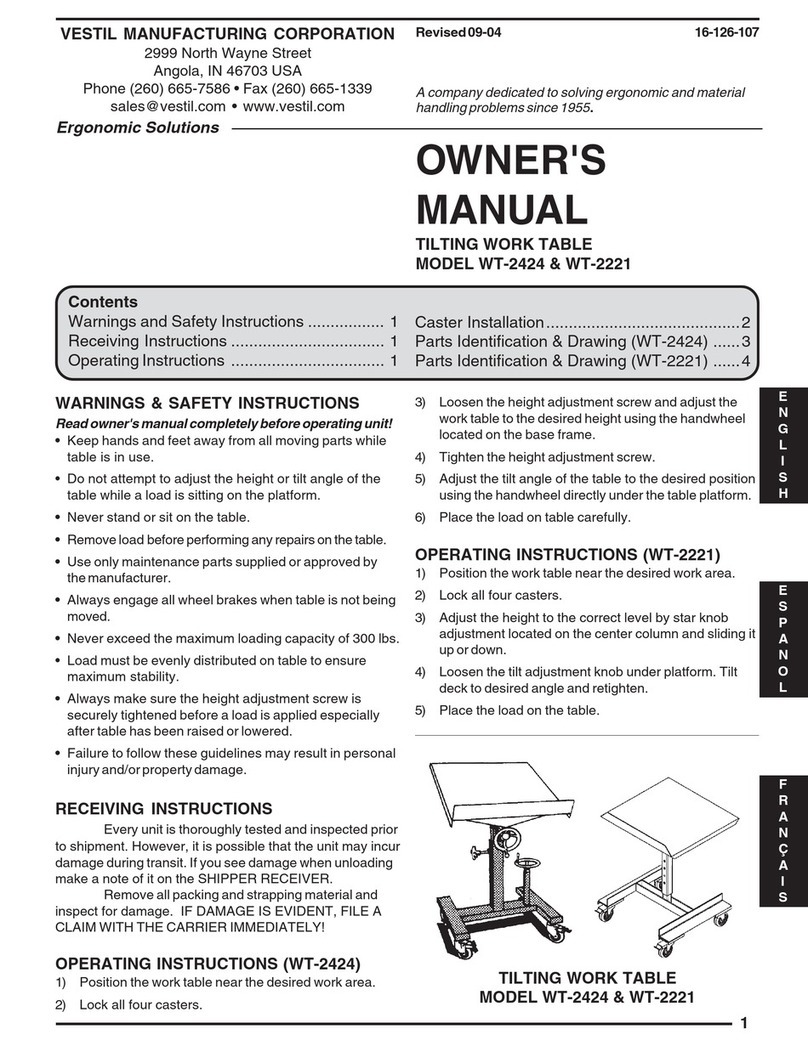
Vestil
Vestil WT-2424 owner's manual

Kendall Howard
Kendall Howard ESDW-9630-1000 owner's manual
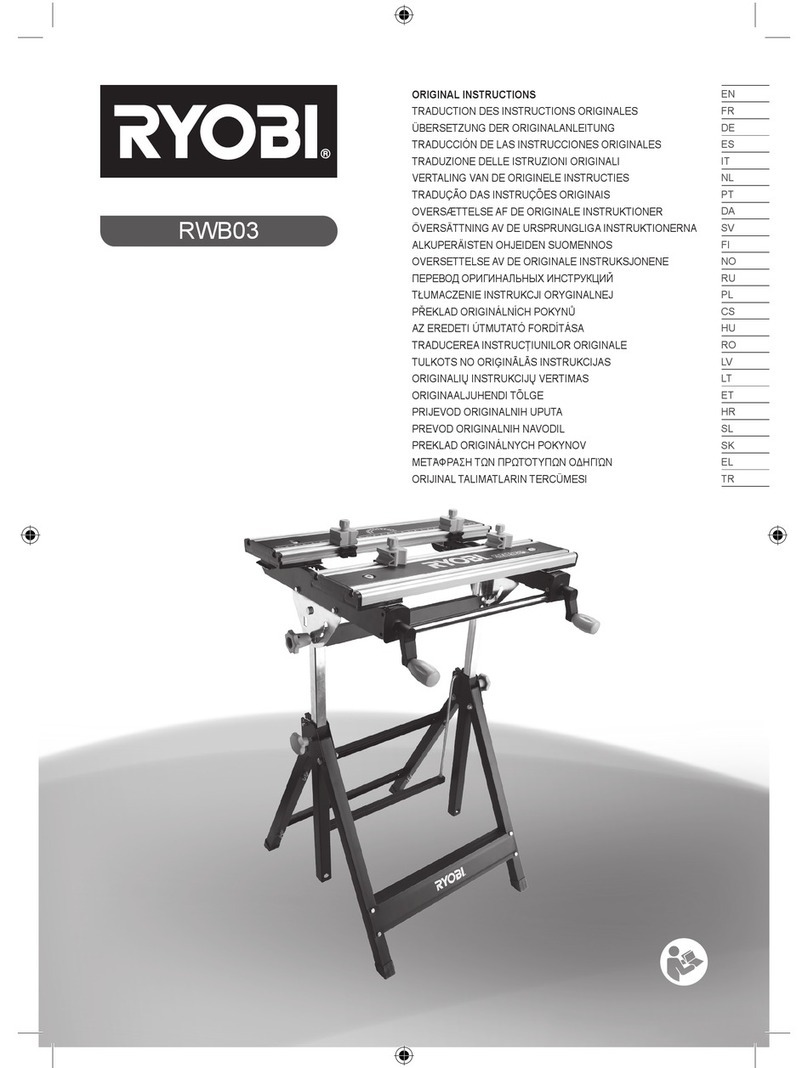
Ryobi
Ryobi RWB03 Original instructions

Husky
Husky H27CH5TR4BGK Use and care guide

Scheppach
Scheppach ts 2100 Translation from original manual
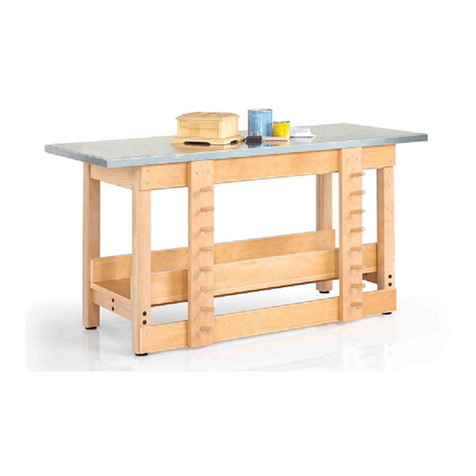
DIVERSIFIED WOODCRAFTS
DIVERSIFIED WOODCRAFTS SHAIN GSB-6024 Assembly instruction
